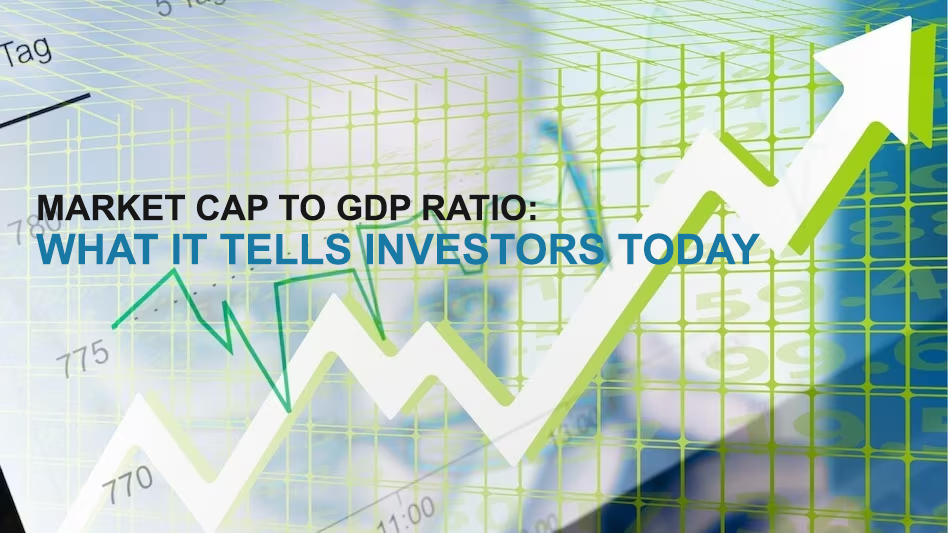Market Cap to GDP Ratio: What It Tells Investors Today

Table of Contents
What Is the Market Cap to GDP Ratio?
The Market Cap to GDP ratio, or Buffett Indicator, compares the total market capitalization of publicly traded companies in a country with its Gross Domestic Product (GDP). Warren Buffett has
famously referred to it as “probably the best single measure of where valuations stand at any given
moment.”
Formula:
Market Cap to GDP Ratio = (Total Market Capitalization / GDP) × 100
When the ratio is high, it may indicate that stocks are priced higher than the economy can justify — a sign of possible overvaluation. A lower ratio might signal undervaluation, providing potential entry points for long-term investors.
How to Calculate It
To calculate the Market Cap to GDP ratio, follow these steps:
- Step 1: Find the total market cap of all listed companies in a given country (available on
stock exchange or financial data platforms). - Step 2: Retrieve the country’s nominal GDP.
- Step 3: Plug the values into the formula.
For example:
- If the market cap of a country is $10 trillion and its GDP is $5 trillion, then:
Market Cap to GDP Ratio = ($10T / $5T) × 100 = 200%
This result would suggest that the market is significantly overvalued.
Interpreting the Ratio
Here’s how to understand the valuation landscape using this ratio:
| No | Ratio Range | Interpretation |
|---|---|---|
| 1 | Below 50% | Strongly Undervalued |
| 2 | 50% - 75% | Modestly Undervalued |
| 3 | 75% - 90% | Fairly Valued |
| 4 | 90% - 115% | Modestly Overvalued |
| 5 | Above 115% | Significantly Overvalued |
These thresholds act as rough guidelines. Economic context, interest rates, and technological innovation may temporarily shift these boundaries.
What History Tells Us
The Market Cap to GDP ratio has historically served as a leading warning indicator before major market corrections:
- Dot-com Bubble (2000): The ratio in the U.S. soared past 140%, well above historical
norms. A crash followed. - Financial Crisis (2008): Once again, the Buffett Indicator surged above 110%, followed by
a sharp downturn. - Post-COVID Rally (2020-2021): Fueled by liquidity and stimulus, the U.S. ratio hit over
200%.
Each of these periods featured euphoria unanchored from economic fundamentals — a red flag that the Buffett Indicator identified
Global Perspectives: U.S. vs. India
Let’s explore current market dynamics using the latest data from early 2025:
United States
- Buffett Indicator: ~180%
- Historical Median: ~80%
- Interpretation: Significantly overvalued
The U.S. market has cooled slightly from its 2024 highs (over 200%), yet remains elevated. Tech
exuberance, artificial intelligence hype, and easy monetary policy have contributed to inflated
valuations.
India
- Buffett Indicator: ~96.86%
- Historical Median: 70-90%
- Interpretation: Modestly overvalued
India’s economy continues to expand, and its stock valuations reflect optimism. However, the drop
from 133% (2021-22) to under 97% suggests healthier re-alignment with fundamentals.
These snapshots show how different economies can exist at distinct stages of market cycles—a
powerful insight for global investors.
Key Limitations of the Buffett Indicator
❌ Exclusion of Private Companies
GDP includes private sector output, but the indicator only accounts for public company valuations. This skews accuracy in countries with large private economies.❌ Global Revenue Distortion
Multinational companies often generate a significant portion of their earnings abroad. U.S. tech giants, for example, have global revenue streams, yet the ratio uses domestic GDP.❌ Influence of Interest Rates
Influence of Interest Rates In ultra-low interest environments, equity valuations often inflate as investors chase yields. This can push the ratio higher even when earnings don’t support it. Because of these constraints, investors should never rely on this metric in isolation.Using It with Other Financial Metrics
To gain a fuller picture of market valuation, pair the Market Cap to GDP ratio with complementary indicators:
- P/E Ratio (Price-to-Earnings): Shows how much investors are willing to pay per dollar of earnings.
- EV/EBITDA: Offers a cleaner view of company valuation by including debt and removing
taxes. - Shiller P/E (CAPE): Smooths earnings over 10 years for cyclical context.
- Dividend Yield: High yields often suggest undervaluation.
- Debt-to-GDP Ratio: Helps assess fiscal health.
A multi-metric approach helps investors avoid confirmation bias and get a balanced view.
Final Thoughts and Next Steps
The Market Cap to GDP ratio is not a crystal ball, but it is a strong spotlight. It reveals when
optimism outweighs fundamentals or when fear undervalues assets.
Used wisely, it can help:
- Time market entries or exits more strategically
- Evaluate overall market health
- Identify bubbles in their early stages
But remember Warren Buffett’s timeless advice: “Risk comes from not knowing what you’re doing.” The Buffett Indicator helps you know a little more.
📣 Next Steps: Invest with Insight
To deepen your understanding of market valuations:
- Study historical applications of the Buffett Indicator
- Combine it with tools like the P/E ratio, yield curves, and sector analysis
- Consult a financial advisor for tailored portfolio strategies
Don’t just watch the market. Understand it